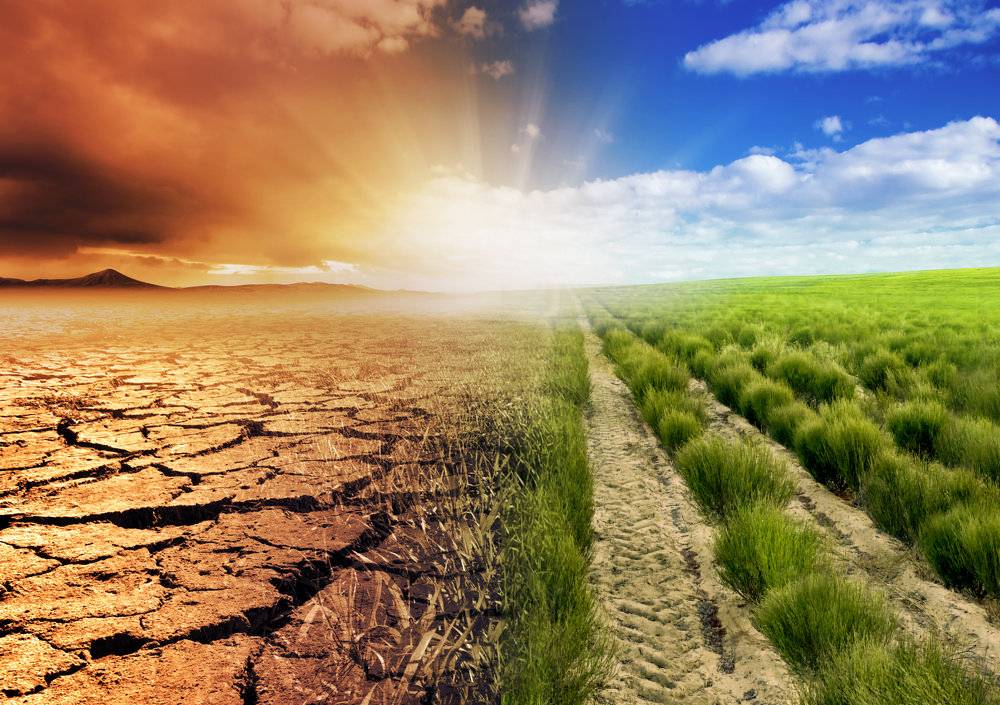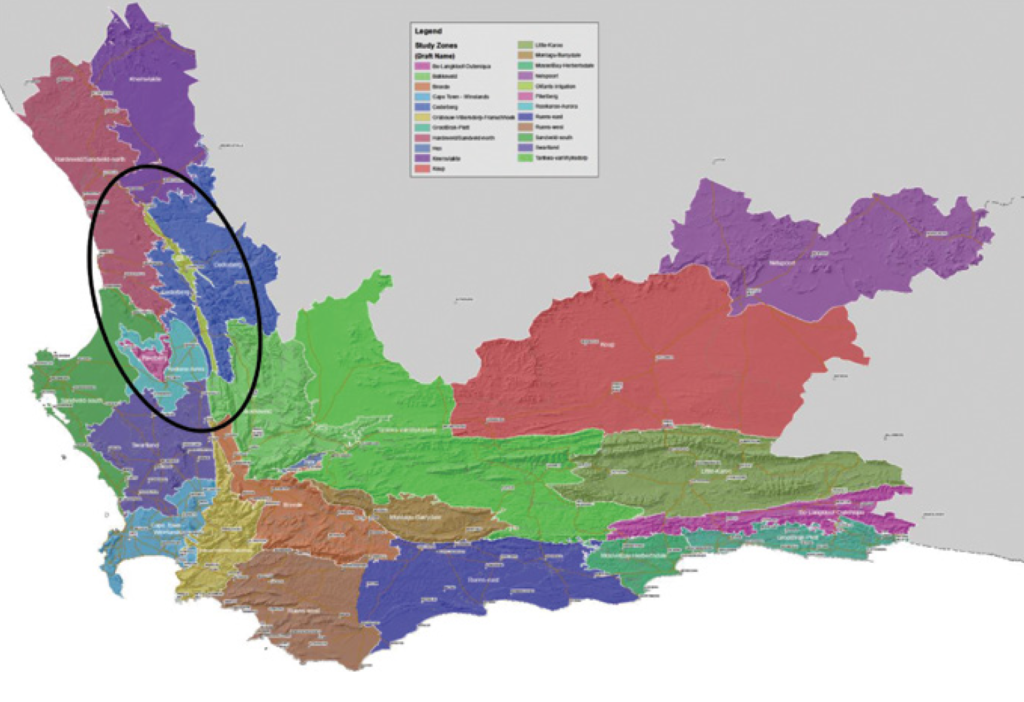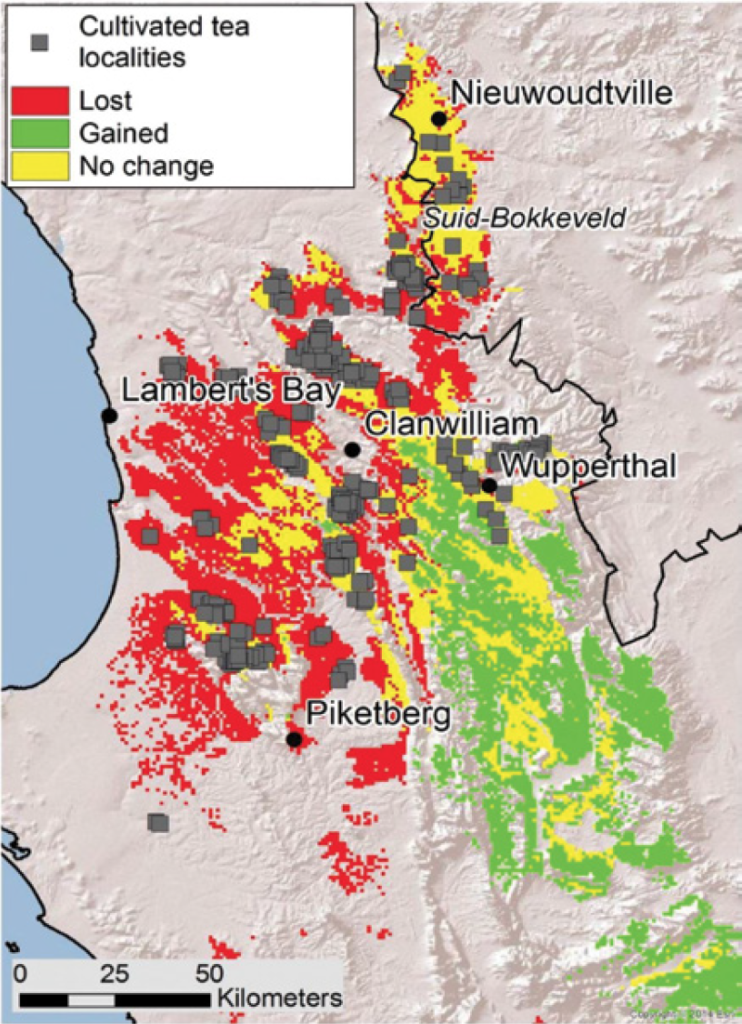In this article we look at issues related to rooibos and climate change and unpack historical data and contemporary meteorological patterns, to provide a summary of the challenges affecting the rooibos-growing region.
We also provide an overview of the solutions developed by farmers and producers, in order to present a full picture of measures being taken to address the challenges faced by rooibos as a result of climate change.
Historical and Seasonal Trends In The Rooibos Region
Over recent decades it has become increasingly evident that a shift to a warmer climate characterised by higher temperatures in the peak of summer every year is now a reality across the globe. For the Western Cape of South Africa this means the entire province faces a warmer and drier future. In the rooibos-growing region of the Cederberg, which has a climate that typically faces extremely hot and dry summers, this presents a challenge.
The entire rooibos production region has always been highly drought affected, with total industry production volumes shifting in lockstep (sometimes up to 50%) with cyclical variation in rainfall. Layered over the short-term cyclical variability is the longer-term impact of climate change which is resulting in a progressively drier and hotter climate for the entire rooibos production region. This has resulted in bulk buyers of rooibos (and their consumers) experiencing stock-outs, quality variation, and large changes in price. This is not good for business and is a challenge for farmer-producers.
With agricultural production directly linked to weather patterns, changes in these patterns have a significant effect on crop health at every stage of a plant’s life cycle. There are obvious ways in which this can be disastrous for farmers. If rainfall patterns shift dramatically, the establishment of a new crop or its vigour and growth can be directly impacted. Equally, there are also less obvious issues related to shifts in weather patterns. For example if there is an unusual increase in rainfall during harvest time this will have a negative effect on the quality of the harvest, or delay it significantly to the extent that the window of opportunity to harvest a crop at its prime may be reduced.
Map of the Western Cape Province showing the 23 agro-climatic zones used in the SmartAgri project, and the Cederberg-Olifants-Sandveld region rooibos production region (circle)
For the Cederberg region – which is the only area in the world where rooibos is grown, and is the region in which it is endemic – the forecast according to a significant number of studies is quite clear. According to ‘A Status Quo Review Of Climate Change and the Agricultural Sector of the Western Cape (Brief for the Rooibos Sector), a SmartAgri research brief published in 2016:
“Climate modelling studies show with a high degree of certainty (i.e. almost all the models agree) that the western parts of the province will experience continued warming and reductions in winter rainfall by mid-century and thereafter. An important change in the climate system involves the shifting of the rain-bringing frontal storm tracks further south during winter. However, the influence of the mountains and ocean will lead to more complex results at local level, particularly for rainfall. In the short to medium term, these influences could lead to increased rainfall on the windward mountain slopes, for example, or rainfall shifting into autumn and spring.”
This summary presents a picture of weather patterns in the Cederberg changing from a historically more reliable scenario of wet winters and dry summers towards less certainty around seasonal rainfall. This raises some questions: if the rooibos plant has evolved to survive and depend upon a yearly wet/dry cycle, how would changes to climate and rainfall impact the plant? And what measures can be taken to mitigate against the fluctuation of seasonal patterns?
In answering the question of how changes to climate and rainfall could affect the rooibos plant and the region it grows in, a recently published study on potential implications of climate change for rooibos production and distribution in the greater Cederberg region provides some clues. The study is in part informed by researcher Dr. Daleen Lötter’s 2015 PhD thesis on the matter, in which she states that “rooibos would experience substantial range contraction, as well as south-eastward and upslope shifts”, among other changes.
Suitability of areas for cultivated Aspalathus linearis under future climate change for the period 2041-2070, showing areas where range contraction, no change, and range expansion occur relative to the current climate (1960 – 1990). Source: Daleen Lötter.
In answering the latter question of what measures can be taken to mitigate against changes in rainfall and seasonal patterns, Dr. Lotter’s research team found that “implementing other water demand management practices, such as green mulches between plant rows to limit water losses and contour ridges on sloping terrain to trap runoff, would also be appropriate adaptation strategies to cope with the expected dry conditions in future.”
Framing the impact of climate change projections within the context of habitat loss as a result of changing rainfall and temperatures, Lotter’s 2015 thesis states: “Estimates of the potential impact of climate change on rooibos tea using a spatial distribution model (MaxEnt) predict that wild rooibos tea may lose up to 88.7% and cultivated tea 75.5% of their climatically suitable habitat range by 2070 (Lötter et al., 2014).”
The overall forecast provided by this research is that the rooibos plant’s capacity for adaptation will be severely tested if climate modelling projections are correct and come to bear. The bigger question is ‘how will the rooibos plant respond to a decrease in rainfall, and an increase in temperature?’.
Rooibos and Phenotypic Plasticity
Though rooibos is adapted to grow in a region that is subject to very hot and dry summers, extreme heat in the summer and reduced winter rainfall has an effect on the growth pattern of the plant. In responding to environmental change, plants express different characteristics in order to adjust to changes in sun, heat, wind, rainfall and humidity. In botany, this is known as ‘phenotypic plasticity’.
Depending on the specific climatic challenges these changes can be expressed in a variety of different ways. Among these phenotypic adaptations can be a range of changes that include stunted or exaggerated growth, greater resources being dedicated from leaves to roots (or vice versa), longer or shorter leaves, and more. All of these are responses that enable the plant to better survive and successfully pass on genetics to the next generation of its type.
It might be reasonably expected that a hardy plant prone to survival in a zone that’s renowned for temperatures below freezing in winter and above 45 degrees Celsius in summer would be able to adapt to ongoing changes over time. However, the fact is that any plants’ evolutionary adaptation will likely not be able to keep up with the speed at which climate change is affecting our planet. Changes in weather patterns experienced in recent years in combination with these being predicted as becoming increasingly erratic suggest that significant environmental stress will be placed on the rooibos plant in the future.
In the rooibos-growing region changes over the short term are related to less rainfall in winter, later rains into spring, and higher temperatures in summer. This combination results in the plant expressing adaptation in two ways. Firstly, by growing fewer and smaller leaves, to counter the respiration required to survive the extreme heat of summer. Secondly, by growing deeper roots to ensure constant access to soil moisture in a climate that is growing hotter and drier.
In extremely dry times wild rooibos plants have been observed developing roots of over 5 metres in response to finding water at lower levels in the soil. This allocation of energy in turn affects the plant’s ability to produce leaf matter. The resulting harvested rooibos then consists of a greater amount of twigs and sticks – and less leaf matter. As it’s the leaf matter which comprises the bulk of high-quality rooibos tea this presents a challenge to farmers and producers – and it’s the area in which efforts and enterprise are being focused, in order to develop solutions.
The big question is “How do you regulate and manage a rooibos crop to mitigate against the negative effects of climate change?” The answers to this question involve a range of responses that farmers have devised – and include some ages-old farmer wisdom, as well as 21st century technological responses.
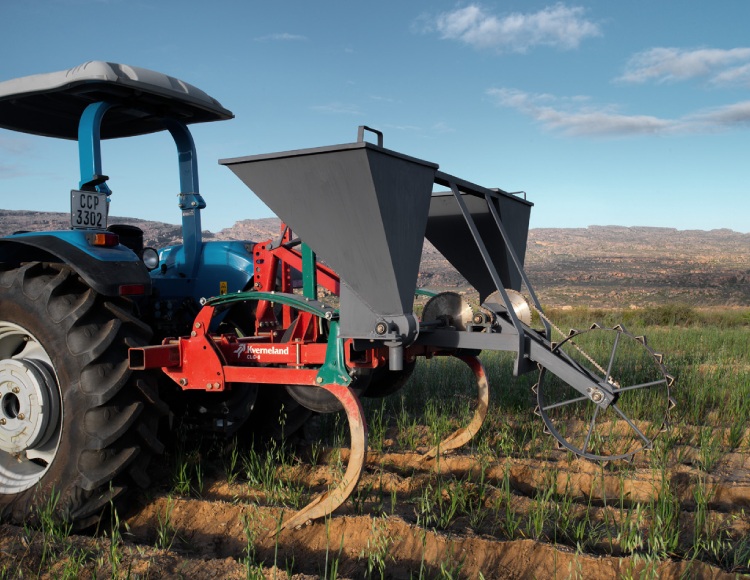
Preparing the soil ahead of planting season at Klipopmekaar
Challenges and Solutions in a Time of Climate Change
In order to provide the ideal growing environment for the rooibos plant farmers incorporate a wide range of traditional and modern farming practices that seek to build the most crucial factor that determines plant health: the soil.
As a leader in organic rooibos production our focus has always been on building healthy soils which retain more moisture. This is achieved by building living soils and working to increase the amount of organic matter and carbon in the soil.
At Klipopmekaar we practise regenerative agriculture and a no-till approach, which means the soil structure and micro-organic biodiversity of our fields is carefully preserved for long-term soil health. There can however be a downside to the no-till approach: when soil is not turned through tilling, many weed species’ seeds can survive – and when they do so, they can compete with crops in areas where water is scarce for much of the year, as is the case in the rooibos-growing region.
A solution to this challenge is diligent weeding by hand but as with all aspects of labour-intensive practices in agriculture this takes time, and time is money. Ultimately for marginal farms whose operational budgets are affected by rising costs, this can impact the vigour of their crops. Unfortunately for marginal farms whose budgets are affected by rising costs and undulating prices, they may not be able to afford extensive hand-weeding.
Fields are generally prepared to be ready for planting in early winter, which in the rooibos-growing region means the preparation is done immediately prior in April and May, and also in prior fallow years(s) when fields are planted with rotational cover crops.
Looking further back in the cycle, rooibos crops at the end of their production life cycle should be mulched rather than ploughed or burned in order to increase soil organic matter. When preparing fields for cultivation, a no-till approach is optimal. When wanting to tackle compacted soils, farmers should use tine implements rather than any ploughs (which turn the soil). Farmers should plant when they receive sufficient rain in order to give the rooibos seedlings the best chance at establishing well before the spring heat begins.
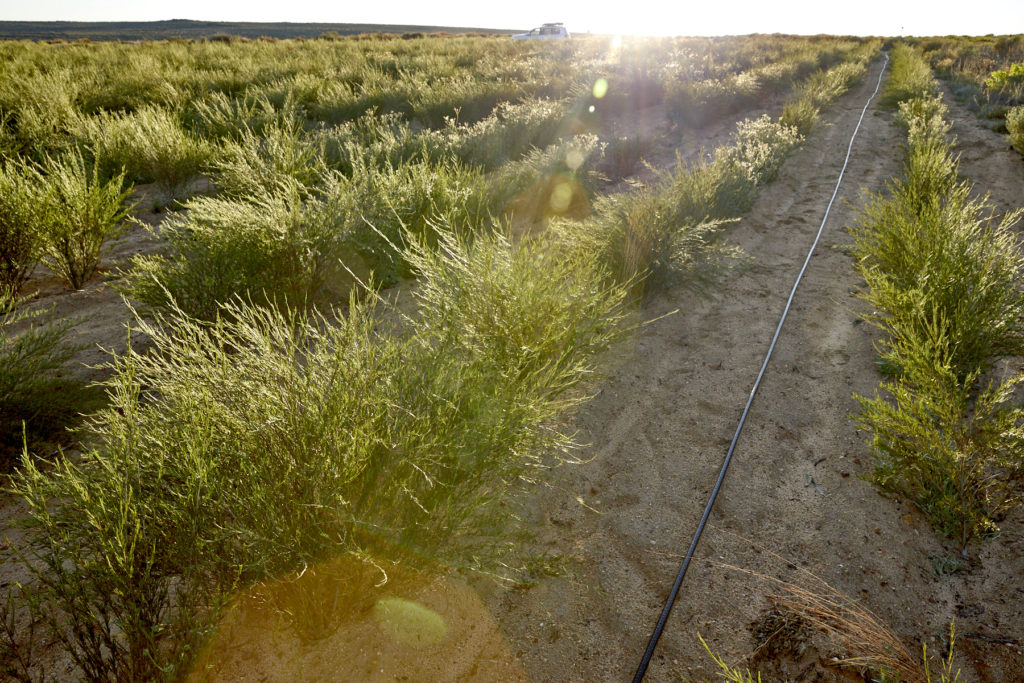
Sustainable supplementary irrigation of rooibos at Klipopmekaar
Rooibos Irrigation
As we understand it, in recent times a number of farmers have experimented with centre-pivot irrigation with varying success. Centre-pivot irrigation is not an efficient use of water and, generally speaking, is optimal for frequent irrigation rather than deep soil irrigation.
In 2015 Klipopmekaar began work with a team of experts to initiate a series of large-scale rooibos irrigation trials. After years of research, trials led to Klipopmekaar becoming the first farm in the industry to apply supplementary irrigation to rooibos on a large scale. These irrigation systems have been designed for the long-term: they are green & sustainable, solar-powered, closed-loop, and generate negligible evaporation. These systems enable us to carefully supplement shortfalls in precipitation (annually and/or seasonally) and mitigate the negative effects of drought as/when necessary.
In developing this approach the primary focus was to find ways to effectively apply irrigation over a large area, whilst minimising evaporation and keeping the use of materials and energy to a minimum.
Key findings from Klipopmekaar irrigation experiments include:
- Rooibos should principally be irrigated on a supplementary basis. It is historically a dryland crop; farmers can irrigate to counteract and reduce the impact of damaging drought cycles and unusual weather events. It is our view that farmers should not irrigate to simply turbo-charge growth as this creates quality challenges. Rooibos plants need to stress prior to harvest.
- Rooibos irrigation (like all agricultural irrigation) should be designed and implemented to be highly water efficient with negligible evaporation loss. Water use must be sustainable and preferably powered with renewable energy sources. Irrigation should be applied when required with deep penetration; not frequently and shallow. We have found drip irrigation systems which are correctly designed and operated in sync with rooibos plant botany to be optimal.
According to Richard Bowsher, farmer at Klipopmekaar: “Climate change and cyclical drought are both very serious threats to rooibos farmers sustainability; both negatively impacting the farmers total annual production volumes and their consistent rooibos crop quality. In response to these threats, we have carefully trialled and analysed rooibos irrigation for over five years since 2017. We have found that the supplementary irrigation of rooibos has distinct benefits to our farming business and our clients. The principal benefits are longer rooibos crop life, much more consistent year-to-year farm crop yield, and generally improved rooibos quality.”
Supporting the thinking that spurred on the investigation and application of the irrigation of rooibos at Klipopmekaar, a 2021 study carried out by University of Cape Town researcher Rhoda Adaramola, found that:
“Increased supply of soil moisture enhances the production of biomass yield in rooibos in the field. Also, rooibos extracts moisture from a deeper soil layer, which enables it to hydrate its leaves and to transpire during the summer period for better growth and biomass production. Water loss through evapotranspiration was high in rooibos fields, and thus mulching of the plants would be beneficial for increased biomass production. However, even better rooibos yields were obtained when mulching was combined with irrigation”.
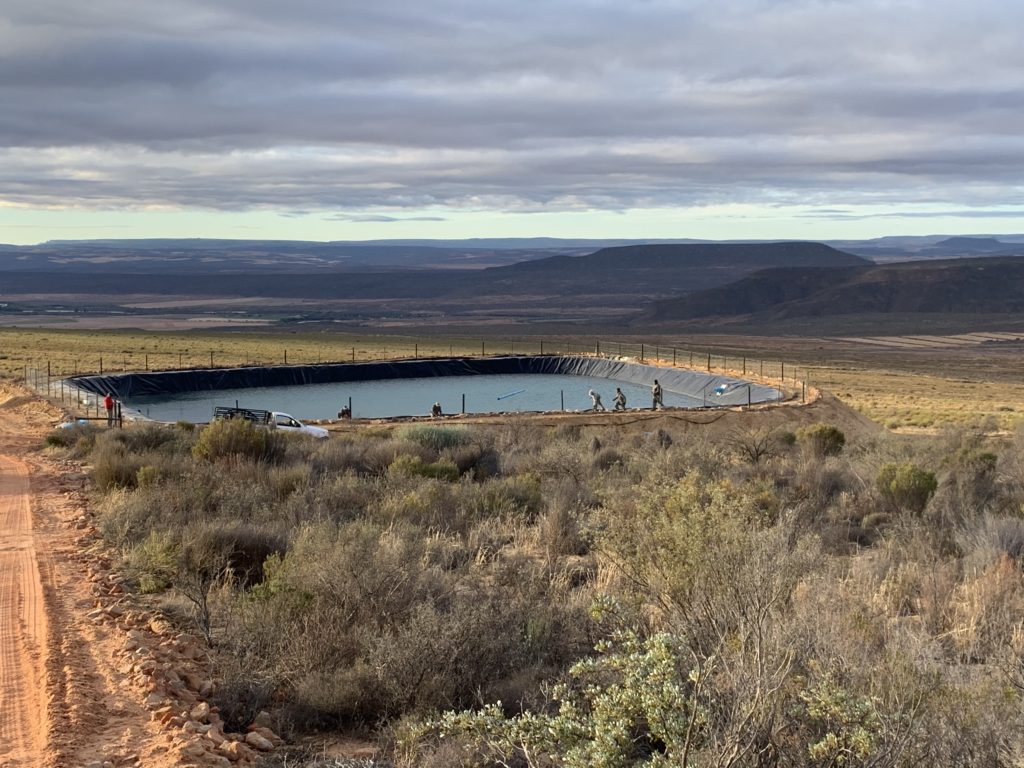
Moving Production South-East
For many farmers in the rooibos industry irrigation is not really an option for various reasons. Firstly, having been traditionally a dryland crop, they may well not have access to sufficient water on their farms. Secondly, low farm gate prices for rooibos may mean that they cannot finance costly irrigation systems. And, of course, water which is available may be better allocated to higher value agricultural purposes. The farmers position in the rooibos market value chain is key to such considerations.
Some rooibos farming businesses have pursued or rented rooibos-arable land south and east of the traditional rooibos production region, the principal reason being to have more chance of higher rainfall. This is being done with some success in the industry, but the purchase or leasing of lands in higher rainfall areas is more costly. The areas in consideration are also better suited for farming other higher-value agricultural crops.
As one moves south-eastwards in the Western Cape and toward the southern Cape one may not find the optimal soil types and summer climate conditions for the primary processing of rooibos tea. Therefore, such production can be negatively impacted by the transport of harvested rooibos to the northwest, where it can be primary processed on the industry’s tea courts.
An additional factor related to the migration of production to areas of greater rainfall is that in some areas soils do not drain well either because they are too shallow or and / or not sandy enough. This again presents an issue as waterlogged rooibos plants can die off as a result of higher than optimal rainfall.
In Conclusion: The Importance Of Trapping Carbon In Soil
Like farming everywhere, the future of rooibos farming lies in understanding how best to work with nature on her terms. Only by taking a considered and responsive approach which improves living soil health can agriculture evolve toward being truly successful and resilient to challenges such as climate change.
Ultimately it is worth noting that healthy untilled living soils trap large amounts of carbon, which would otherwise be released into the atmosphere, and in turn actually cause climate change itself.
Over the last decade we’ve learned a great deal – but as much as we have learned we are aware that this is an iterative process, with each season teaching us new lessons. As we learn, so we grow – and we’ll continue to bring you updates as we take our next steps towards a fertile future.
References:
- A Status Quo – Overview on Climate Change and the Agricultural Sector in the Western Cape’ (Brief for the Rooibos Sector) – SmartAgri, ACDI (2016)
- ‘Projected Climate Change Threatening Production of SA’s Unique Tea’ – Sue Matthews, ‘The Water Wheel’, South African Water Research Commission (2022)
- ‘Relationship between Aspalathus linearis (Burm. F.) R. Dahlgren (rooibos) growth and soil moisture in a glasshouse and in the DSSAT-CSM crop model’ – Rhoda Adaramola (2021)
- ‘Potential implications of climate change for Rooibos (A. linearis) production and distribution in the greater Cederberg region, South Africa.’ – Dr. Daleen Lötter (2015)

